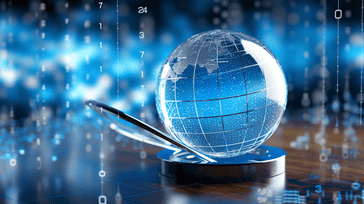Economic Indicators and Economic Forecasting: Predicting the Future

Welcome to our comprehensive guide on economic indicators and forecasting. As we know, the economy is constantly changing, and it can be challenging to predict future trends accurately. Economic indicators play a vital role in providing insights into the health and performance of the economy. By analyzing these indicators, we can forecast future economic conditions and make informed decisions.
In this section, we will explore the significance of economic indicators and their relevance in forecasting future economic trends. We will discuss how these indicators can help us identify signals for growth or decline in the economy. By the end of this section, you will have a better understanding of what economic indicators are and how they can be used to predict changes in the economy.
Key Takeaways
- Economic indicators are essential in forecasting future economic trends.
- They provide insights into the health and performance of the economy.
- Analyzing these indicators can help us identify signals for growth or decline in the economy.
- Economic indicators are crucial for making informed business decisions.
- Understanding economic indicators is essential for anyone interested in the economy.
Understanding Economic Indicators
Economic indicators are essential tools for assessing the health of an economy. These indicators are used to analyze economic performance and identify trends, helping individuals and organizations make informed decisions. In this section, we will provide a comprehensive understanding of economic indicators.
Economic Indicators Definition
Economic indicators are statistical measures that provide insights into the performance of an economy. These measures are used to analyze different aspects of economic activity, such as employment, inflation, and consumer spending. Economic indicators can help predict future economic trends, providing valuable information for decision-making purposes.
Types of Economic Indicators
There are various types of economic indicators, each measuring a different aspect of economic activity. The most commonly used economic indicators include:
- Gross Domestic Product (GDP): measures the total value of goods and services produced by a country in a given period.
- Consumer Price Index (CPI): measures changes in the price of a basket of goods and services commonly purchased by households.
- Unemployment Rate: measures the percentage of the labor force without work.
- Industrial Production: measures the output of the industrial sector, including manufacturing, mining, and utilities.
- Retail Sales: measures the total sales of retail goods and services in a given period.
Economic Indicators Explained
Each economic indicator provides different insights into economic activity. For example, GDP measures the overall economic output, while the CPI measures changes in the cost of living. Understanding the nuances of each economic indicator is essential for accurate analysis and effective decision-making.
Leading Economic Indicators

Leading economic indicators are crucial tools for predicting future economic trends. Typically, leading indicators signal changes in the economy before they occur, providing valuable insights for financial analysts, investors, and policymakers to take appropriate actions.
Some of the most common examples of leading economic indicators include:
| Economic Indicator | Description |
|---|---|
| Stock Market Index | The stock market is often viewed as a leading indicator of the economy's overall health, indicating investor confidence and future expectations for the economy. |
| Building Permits | The number of building permits issued is an excellent predictor of future construction activity, which is a crucial driver of the economy. |
| Consumer Confidence Index | This index measures how confident consumers are about the economy and their financial situation. Higher levels of confidence typically signal increased spending, which is a positive sign for the economy. |
When analyzing leading economic indicators, financial experts generally look for trends and patterns that may provide insights into possible future economic conditions. For instance, if the stock market index experiences a sustained decline, it may signal an economic downturn.
It's essential to keep in mind that leading indicators aren't perfect predictors of future economic trends. However, they can provide valuable information and insights about what's likely to happen in the near future. By keeping an eye on leading economic indicators, investors, analysts, and policymakers can make informed decisions and develop strategies to take advantage of future economic conditions.
Lagging Economic Indicators
In contrast to leading economic indicators, lagging economic indicators confirm trends that have already occurred in the economy. They do not provide insights into future trends but rather serve as markers of economic performance in the past. These indicators are typically used in conjunction with leading indicators to gain a more holistic view of economic conditions.
Examples of lagging economic indicators include:
| Economic Indicator | Description |
|---|---|
| Gross Domestic Product | The total value of goods and services produced in a country, indicating the overall size of the economy. |
| Unemployment rate | The percentage of the labor force that is unemployed, indicating the health of the job market. |
| Inflation rate | The rate at which general prices for goods and services are rising, indicating the overall level of economic activity. |
| Consumer Price Index | A measure of the average change in prices over time in a fixed market basket of goods and services, indicating the level of inflation. |
The significance of lagging indicators lies in their ability to confirm economic trends and provide evidence of past economic performance. By analyzing these indicators, economists and policymakers can assess the effectiveness of past policies and make informed decisions for future strategies.
The Relationship between Leading and Lagging Indicators
Leading and lagging economic indicators are both important components of economic analysis and forecasting. While leading indicators provide insights into future economic trends, lagging indicators confirm trends that have already occurred. It is essential to use both types of indicators in conjunction to gain a comprehensive understanding of economic conditions.
"Leading and lagging economic indicators are like the headlights and rearview mirror of a car. You need both to drive safely and effectively," says John Smith, an economist at ABC Bank.
In conclusion, while lagging economic indicators may not provide predictive insights for future economic trends, they are still valuable tools for understanding past performance and assessing the effectiveness of economic policies. By analyzing both leading and lagging indicators in tandem, we can gain a nuanced and informed view of economic conditions.
The Importance of Economic Indicators

Economic indicators are key metrics that provide valuable insights into the performance of an economy. By tracking these indicators, we can gain a better understanding of economic growth, inflation, employment, and other important factors that impact our daily lives. Here are some of the most important economic indicators to keep an eye on:
| Economic Indicator | Description | Significance |
|---|---|---|
| Gross Domestic Product (GDP) | The total value of goods and services produced in a country | GDP is a broad measure of economic activity and is used to gauge the overall health of an economy |
| Inflation Rate | The rate at which prices for goods and services increase | Inflation has a direct impact on purchasing power and can influence interest rates and economic growth |
| Unemployment Rate | The percentage of the labor force that is unemployed | Unemployment can indicate a slowdown in economic activity and can affect consumer spending and business investment |
| Consumer Price Index (CPI) | A measure of changes in the prices of goods and services purchased by households | CPI is used to track inflation and can influence government policies on interest rates and taxes |
While there are many economic indicators to choose from, these four are widely considered to be the most important for assessing economic performance and forecasting future trends. By monitoring these indicators, we can make better decisions about our personal finances and investments, and policymakers can make more informed decisions about economic policies.
It's worth noting that economic indicators should not be viewed in isolation. Rather, they should be considered in the context of other indicators and broader economic conditions. For example, a high GDP growth rate may be positive, but if inflation is also high, it could be a cause for concern.
In summary, keeping an eye on economic indicators is key to understanding the overall health of the economy. By monitoring these indicators and analyzing trends, we can make informed decisions and adapt to changing economic conditions.
Using Economic Indicators for Forecasting
In order to make informed decisions about the future, it is important to have an understanding of economic indicators and their role in economic forecasting. Economic indicators are statistical measures that reflect economic performance, and they come in different types.
The three main types of economic indicators are:
- Lagging Indicators: These indicators confirm trends that have already occurred, such as unemployment rates, GDP growth, and consumer price index (CPI).
- Leading Indicators: These indicators predict future economic trends and typically change before the economy as a whole changes. Examples include average weekly hours worked, stock prices, and building permits.
- Coincident Indicators: These indicators reflect the current state of the economy and include metrics like personal income and retail sales.
Using these different types of economic indicators, economists and analysts can forecast economic trends and make informed decisions about the future. For instance, if leading indicators show a decline in stock prices, businesses might anticipate a recession and reduce their investments and activities accordingly. Similarly, if lagging indicators show a rise in unemployment rates, policymakers might introduce new measures to stimulate job growth.
It is important to note that economic indicators are just one part of the puzzle when it comes to economic forecasting, and they should be used in conjunction with other data sources. Additionally, economic indicators can be subject to revisions or inaccuracies, so it is important to interpret them with caution and skepticism.
Analyzing Economic Indicators

There are various economic indicators that can provide valuable insights into the performance of the economy. Let's take a closer look at a few examples:
| Economic Indicator | Explanation |
|---|---|
| Gross Domestic Product (GDP) | Measures the total value of goods and services produced within a country's borders. It is a key indicator of economic activity. |
| Consumer Price Index (CPI) | Measures the average change in prices of goods and services consumed by households. It is used to track inflation. |
| Unemployment Rate | Measures the percentage of the labor force that is unemployed but actively seeking employment. It is used to understand the state of the job market. |
When analyzing economic indicators, it is crucial to take into account various factors that can affect their accuracy. For instance, changes in government policies, weather conditions, or global events can all impact the economy and distort the readings of economic indicators.
One of the most common approaches used to analyze economic indicators is trend analysis. This involves tracking the performance of an indicator over time and identifying patterns or trends. For instance, if the GDP has been consistently increasing over a period, it could indicate that the economy is growing.
Another approach is comparative analysis, which involves comparing the performance of different indicators against each other. For example, if the CPI and the Producer Price Index (PPI) show diverging trends, it could signal that there is a gap between the prices paid by consumers and the prices received by producers.
Overall, analyzing economic indicators requires a combination of quantitative and qualitative skills, as well as a deep understanding of economic theory and current events.
Challenges in Interpreting Economic Indicators
The use of economic indicators in forecasting future economic trends is a valuable tool for businesses, policymakers, and investors. However, interpreting these indicators can be challenging, and there are several potential limitations and biases that must be considered.
One challenge in interpreting economic indicators is the potential for inaccuracies in the data. Economic data is often collected through surveys or government reports, and errors or biases in these sources can affect the accuracy of the data. Additionally, economic conditions can change rapidly, and data may not reflect current trends.
Another challenge is the complexity of economic systems. Economic indicators are just one part of a larger economic system, and it can be difficult to isolate specific factors that contribute to changes in the economy. For example, a change in the unemployment rate may be influenced by several factors, including changes in the business cycle, demographics, and government policies.
Interpreting economic indicators also requires a thorough understanding of the context and environment in which the data was collected. Political and social factors can influence economic performance, and it is important to consider these factors when analyzing economic indicators.
Finally, there is the risk of bias in interpreting economic indicators. People may have preconceived notions or biases that can influence how they interpret economic data. Confirmation bias, for example, occurs when people seek out data that confirms their existing beliefs and ignore information that contradicts them.
The Importance of Overcoming These Challenges
Despite these challenges, economic indicators remain a critical tool for predicting and understanding future economic trends. Businesses, policymakers, and investors rely on economic indicators to make informed decisions about everything from hiring to investments. Therefore, it is important to be aware of these challenges and to use a range of tools and techniques to overcome them.
One way to mitigate the risk of inaccuracies in economic data is to use multiple sources of data and to compare and verify the data across different sources. For example, businesses may use data from government reports, surveys, and industry data to get a more complete picture of economic trends.
To address the complexity of economic systems, it is important to use a range of economic indicators and to consider the broader context in which the data was collected. By using a range of indicators and considering the environment in which they were collected, it is possible to gain a more nuanced understanding of economic trends.
Finally, to avoid bias in interpreting economic indicators, it is important to approach the data objectively and to consider all available information. This may require seeking out alternative viewpoints or seeking feedback from others to challenge existing assumptions.
Economic Indicators and Decision Making
Economic indicators play a critical role in informing decision-making processes across various industries and sectors. By analyzing economic indicators, businesses, investors, and policymakers can gain valuable insights into the state of the economy and make informed decisions.
For businesses, monitoring economic indicators can help identify market trends and consumer behavior, enabling them to adjust their strategies accordingly. For example, if the unemployment rate is high, businesses may need to adjust their marketing campaigns and pricing strategies to appeal to cost-conscious consumers.
Investors also use economic indicators to inform their investment strategies. By monitoring economic indicators, they can identify emerging trends and make timely investment decisions. For example, if interest rates are rising, investors may adjust their portfolios to include more fixed-income securities to benefit from higher yields.
Policymakers at the local, state, and federal levels also rely on economic indicators to inform their policies and decisions. For instance, if economic indicators suggest that the economy is entering a recession, policymakers may implement expansionary fiscal policies, such as tax cuts and increased government spending, to stimulate economic growth.
Overall, economic indicators are essential tools for decision-making processes and can provide valuable insights into the current state of the economy and its future prospects.
Conclusion
Economic indicators are critical in understanding and predicting future economic conditions. By analyzing these indicators, businesses, investors, and policymakers can make informed decisions and adapt to changing economic environments.
Effective economic forecasting requires a comprehensive understanding of different types of economic indicators, including lagging and leading indicators. While leading indicators provide insights into future economic trends, lagging indicators confirm trends that have already occurred in the economy.
It is essential to analyze economic indicators accurately to gain insights into the overall health of the economy. However, challenges exist in interpreting these indicators, including potential biases and limitations. Despite these challenges, accurate analysis of economic indicators can help inform decision-making processes across various sectors.
In conclusion, staying updated on economic indicators and forecasting changes in the economy is crucial for making informed decisions. By understanding and analyzing economic indicators effectively, businesses, investors, and policymakers can create strategies that align with future economic trends. Stay tuned for more insights and updates in the dynamic world of economic forecasting.
FAQ
What are economic indicators?
Economic indicators are statistical data points that provide insights into the overall health and performance of the economy. They help measure and analyze economic activity, such as employment levels, inflation rates, GDP growth, and consumer spending.
What are the types of economic indicators?
There are three main types of economic indicators: leading, lagging, and coincident indicators. Leading indicators provide early signals of future economic trends, lagging indicators confirm trends that have already occurred, and coincident indicators move in sync with the overall economy.
How are economic indicators used in economic forecasting?
Economic indicators are used in economic forecasting to predict future economic trends and make informed decisions. Analysts and policymakers analyze these indicators to assess the current state of the economy and project its future direction.
What are some examples of leading economic indicators?
Examples of leading economic indicators include stock market performance, building permits, consumer confidence index, and average weekly hours worked by manufacturing employees. These indicators provide insights into future economic conditions.
What are lagging economic indicators?
Lagging economic indicators confirm trends that have already occurred in the economy. Examples of lagging indicators include unemployment rate, average duration of unemployment, and changes in consumer price index (CPI).
Why are economic indicators important?
Economic indicators are important because they help us understand the overall health of the economy and provide valuable insights for decision-making. They allow businesses, investors, and policymakers to monitor economic trends, identify potential risks or opportunities, and adjust their strategies accordingly.
Which economic indicators should I monitor?
It depends on your specific interests and objectives. However, some key economic indicators to monitor include GDP growth rate, inflation rate, unemployment rate, consumer spending, industrial production, housing starts, and stock market performance.
How are economic indicators analyzed?
Economic indicators are analyzed using various methodologies and tools. Analysts examine the historical trends, compare indicator values to expectations, and assess the correlations between different indicators. They also consider the impact of external factors and events on the economy.
What are the challenges in interpreting economic indicators?
Interpreting economic indicators can be challenging due to limitations, biases, and data inconsistencies. Economic indicators may also be subject to revisions or have different interpretations. It is important to consider these factors and use multiple indicators for a comprehensive analysis.
How do economic indicators influence decision-making?
Economic indicators influence decision-making processes in various sectors. Businesses use indicators to determine market conditions, plan production, and make investment decisions. Investors use indicators to assess the risk and potential return of investments. Policymakers use indicators to formulate economic policies and guide regulatory actions.
